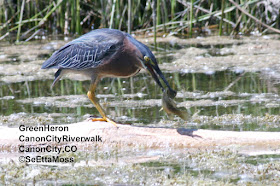
I photographed this Green Heron on a small pond on the Canon City, CO Riverwalk. There have been Green Herons fishing at this pond for a number of years. Sometimes I have found 2 adult Green Herons in this pond at one time and several years ago I saw one carrying nesting material (which, had it been during a Breeding Bird Atlas survey year, would have been considered confirmed breeding). Thoug I have never found an immature Green Heron at this location nor further evidence of breeding, I can't imagine that there would be Green Herons at this location year after year if they weren't breeding either here or somewhere not too far away.

As is not uncommon, this bird was out in the open while many people were walking by; but as it stood motionless for much of the time no one, except me, saw it. I took this pics handheld with the heron about 60-75 feet away on the other side of the pond and it was a good thing as when I returned from going the few hundred yards back to my car for my tripod and camcorder it had been flushed by someone (it's hard enough to carry my dslr with the 400 mm lens on it, and I'm just not up for schlepping my tripod too).

The fish the heron caught may be a Brown Trout--whatever it is, it is certainly a good size fish. The heron is adjusting the position of the fish so it can just swallow it (unfortunately I didn't get good pics of it swallowing the fish). More pics follow. SeEtta

 I was able to get these super close-ups by using my car as a blind. The heron was less than 20 feet away but undisturbed as I was very quiet and moved slowly and stayed in my car. I took the pics with my Canon Xti with a 400mm lens,a 1.4 extender--as the camera is not full framed there is another 1.6 multiplier that nets about a 1000 mm equivalent--plus I cropped the photo but only a little.
I was able to get these super close-ups by using my car as a blind. The heron was less than 20 feet away but undisturbed as I was very quiet and moved slowly and stayed in my car. I took the pics with my Canon Xti with a 400mm lens,a 1.4 extender--as the camera is not full framed there is another 1.6 multiplier that nets about a 1000 mm equivalent--plus I cropped the photo but only a little.  I really like the deep chestnut color on the plumage of this young heron. SeEtta
I really like the deep chestnut color on the plumage of this young heron. SeEtta




































